I needed some high voltage diodes for a project I am working on. Below is information on how to build a few different types and maybe go a bit overboard.
Recently I have been working on rebuilding my energy storage capacitor discharge setup and needed a full wave rectifier bridge for my neon sign transformers. The previous ones were lost over time and during multiple moves and I’m sure I can make better.
The easiest way to make a high voltage diode is to just chain lower voltage diodes together. As an example you may buy microwave oven diodes for around $7-15US each, many of these are rated as high as 350mA at 12kV. With a 12kV NST you would be better off to wire 2 together in series as a minimum. This will give you a 24kV rectifier, which is well above the range of the peak voltage of 12kV neon sign transformer.
For 12kV the voltage peak is about 12kV * 1.414 which is 16,968 volts. This is also the voltage that will be coming out of the DC side of the rectifier and you should take it into account when rating your other components. This is very basic math for sine wave AC sources and does not account for circuit resistance and other factors, in general I have found it to be good enough to calculate part ratings.
In my case I had several hundred 1n4007 diodes sitting in one of my parts bins so I decided to use those, at first. I bought a large quantity of these diodes about 10 years ago and they’ve come in handy again and again for working on new projects and repairing older equipment. They are rated at 1 Amp 1kV each and are pretty cheap $0.12US in small quantities and cheaper in bulk. I wanted to make 35kV chains which required 35 diodes each. The cost for these chains worked out to be $4.20US each so a full-wave bridge 35kV bridge rectifier for about $17US which is much cheaper than using microwave oven diodes or other alternatives, but does require a bit more investment of time to solder them all together.
I tried various methods of soldering them together and the quality progressed through each stage. In the photo below you can see the four chains I built. The top one was the first one, the second one down is the second and so on. The first two were created by cutting the diode leads short and creating tight hooks on either end, then hooking each diode together like a chain and soldering it together. I didn’t like the look of this after the second one so I started to just cut the diode leads short and solder them end to end. (click to enlarge)
I have read some on equalizing resistors and capacitors on long diode changes, but this seems to be mostly a throwback which applies to older diode types and less accurate fabrication. As production technology has improved as well as composition, diodes are less likely to have the issues that required all of that extra protection insurance. Additionally, diodes are so cheap and easy to string together the strings can be made heavily over-rated and replaced as often as needed.
The strings were a bit of work to put together. It took about 20-25 minutes each to solder them.
Now that the diodes are built they need to be contained and made easier to handle as long strings like this they are fragile and prone to breakage or accidental damage. Because they’re so long and it would be hard to use them in a convenient way. Like my past chains these were going to be inserted into PVC tubes with terminals on the end which would provide rigid support.
The other day I was over at All Electronic’s website and found some 6kV rated diodes labeled as R6000 for 50 cents a piece though there doesn’t seem to be any specifications available on them other than 200ma @ 6kv. To make a 36kV diode would take 6 of these and cost $3.00. I ordered 50 of these diodes from All Electronics. These diodes will result in a much shorter diode chain, but they’re similar in size to the 1n4007 and I think they’ll need to be potted to prevent a chance of arc over. You can also find a bunch of different sizes and values on Amazon.
The diodes arrived the other day and this weekend I built up a set of 4 rectifiers out of the 6kV diodes, some PVC, PVC end caps and wax. The diodes are rated only at 30kV which gives me plenty of overhead for the voltages I will be using with the high voltage capacitor discharge experiments. Below you can see the new diode chain, this is 5 x 6kv diodes totaling 30kV of rectification. In use these will be rectifying the power from a 12kV Neon Sign Transformer to charge a 10kV capacitor so they will be operating well within their limits. You may think that sounds crazy, but a NST transformer is current limited. The voltage will drop as current demand increases, as the capacitor charges the current demand is reduced and the voltage begins to increase as current decreases.
I needed some terminals for my high voltage diodes. I just used standard machine screws and soldered the wires onto the ends of the screws. I tried to use a standard screw for all 8 terminals on the 4 diodes but fell short on that, it will just mean a little more digging in my nut bin when I go to hook these up as a full bridge.
Once the wire was soldered to the end of the screw I soldered the other end to the negative end of a HV diode string.
With the screw attached to the negative/cathode end of the diode I drilled holes into the PVC endcaps to allow the screws to fit through and bolted them down securely. I pushed the screw through, held it tight with a JIS screwdriver (which seemed to fit better than a Phillips screwdriver on these machine screws) and tightened the nuts on with a wrench making sure not to stress the leads for the diodes too much.
I also attached some take off leads on the anode end of the diode strings. These leads will be used to connect to the anode end cap once the interior of the PVC pipe has been filled with wax.
As you see above I have already sized some of the 1-inch outside diameter PVC pipe for the diode strings. The long leads coming out the end are a requirement if you plan on attaching the end cap, unless you have some other idea I hadn’t thought of. I glued all the PVC pipes into the negative / anode end caps using regular PVC pipe adhesive.
After the adhesive had cured (most of the way) I melted down quite a few tea-light candles, non-scented and non-colored in a pan on low heat. The tea-light candles I had purchased weren’t even made out of molten wax they were made from granular wax which had been pressed into the a mold. When I took the candles out of the metal holders they pretty much crumbled to dust, this made it easier to break them up into smaller pieces for the melting process.
I didn’t want to spill wax all over the place so I put down a few layers of paper towels on the counter. I then put my trusty ‘science only’ vacuum dish on that, filled the dish with paper towels, wrapped the tubes in paper towels and set them down in the dish. Wax is a pain to clean up and it was cold and dark outside. Below you can see the PVC tubes filled with molten wax. The wax shrunk as it was cooling so it wouldn’t hurt to top it off if needed.
Here’s another shot of the whole wax tray. Once the wax had cooled the paper towels were pretty solid from getting soaked in wax overflow, so I was glad I had gone through the extra efforts.
The wax cooled in the fridge with next weeks lunch supplies for a bit and then I unwrapped the paper towels from the diodes and threw them in the freezer to cool even faster. I would recommend against this as when I pulled them out of the freezer moisture quickly condensed on them and I had to let them dry out for a while. I did test the diodes on high voltage before I capped them, and they all seem to be performing their jobs.
I then prepped the free anode leads much like that cathode leads and put the anode caps on the tube and now I have four fully functioning 30,000 volt diodes which I can use as a full-wave rectifier on my HV capacitor charging project. This should improve my charge rate quite a bit. My last capacitor charging transformer was a 15kv/30ma Neon Sign Transformer. The new charging setup is 2 x 12kv/30ma transformers, so I have doubled the current capacity just in transformers alone, and with a full-wave bridge I will be able to take full advantage of the output, not just the 50% duty cycle of using a single rectifier diode / half-wave rectifier.
I’ve made a video showing the diodes in operation. At the start of the video you can see one of my 12kV / 30mA transformers running in pure AC mode, no diodes. In the second scene you see the transformer being half wave rectified with one of single diodes I made above on one of the power outputs. In the third part of the video you’ll see the transformer running full-wave rectified.

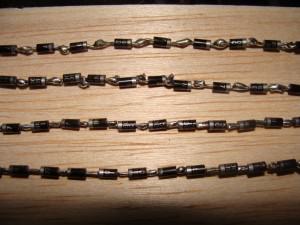
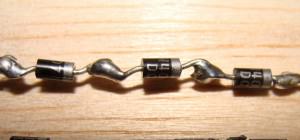
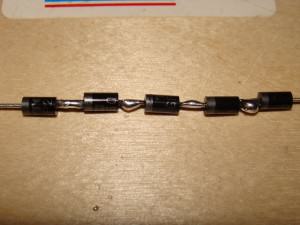
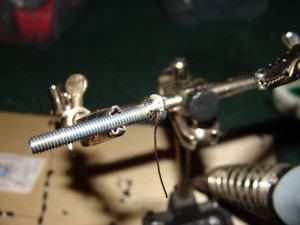
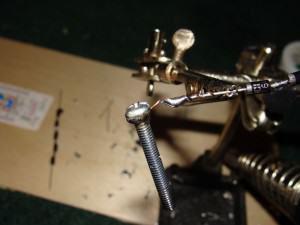
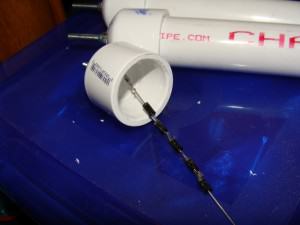
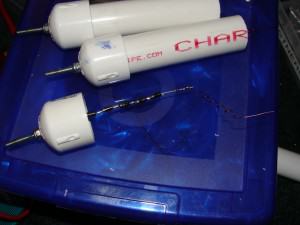
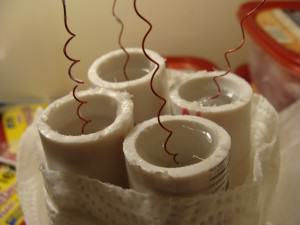
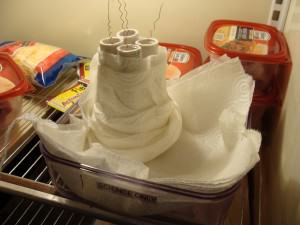
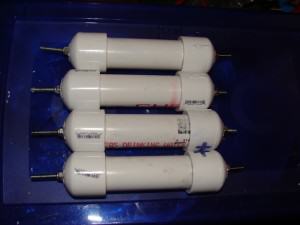
7 responses to Home Made High Voltage Rectifier Using Series Strings of Diodes
i also made high voltage rectifies using string of diode ,but may i know how to test whether it is working or not
This is not an easy test because a complete one is to check the “chain” of rectifiers if they are OK driving the HV you need to, and if they can drive the Current you want to. For HV you just overestimate the total HV it can handle. To test it in HV you need a special HV Circuit and it’s not safe. Butt, you can try this one.
For example: you need to use the rectifiers “chain” of for 10KV and 1Amp.
You will connect in series, 15 – 20 X (1kV / 4 Amps) HV rectifiers.
You can setup a kind of “jig” using DC low voltage to test for current. Use like 12VDC supply and a Load like a 12V/2A light bulb from a car. Supply the Load thru the rectifiers “chain” on 12 VDC direct polarity and reversed polarity. One way the bulb is lighting , the other way is not. That’s all.
useful stuff there, I love high energy. but it can get expensive
just don’t try taking them on a plane!
Nice project! Keeping it simple! Plus you’ll know when one fails if it starts leaking wax. 🙂 BTW, I thought it was pretty hard on diodes to pull an arc from them directly?
Yup, I also built another one out of the same diodes and potted it in a plastic pot and it seems to work okay, though I really need to do some final tests on it to make sure it’s not being weird. The PVC pipes gave me a good isolation of each section and allow for reconfiguration as well. Drawing an arc off them directly may be hard on them, haven’t read that, but they’re still in good shape and conducting only one way 🙂
You can draw a arc over diodes no problem so long as it’s with in load specs of the diode …. So long as the power source is no greater then the actual diodes ratings voltage and amp, then due to loses over the air etc it would only be about 75% if that of a direct short load,
Finished my home made high voltage 30kV full-wave rectifier bridge and updated the post http://bit.ly/cNRypJ
Leave a reply to Home Made High Voltage Rectifier Using Series Strings of Diodes